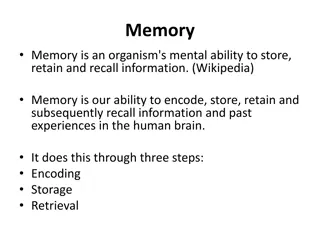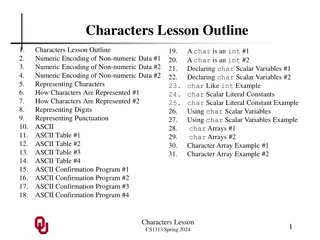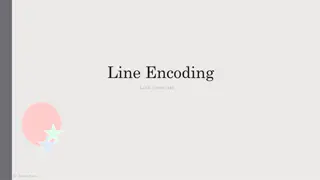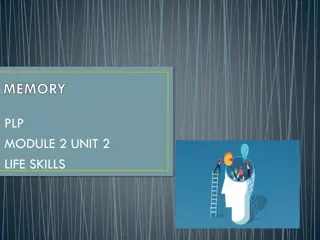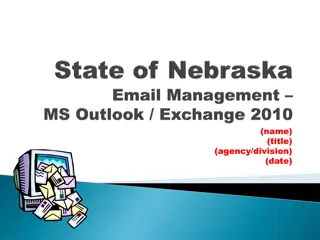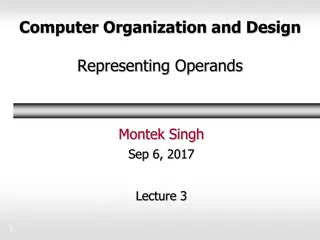Understanding Memory Encoding and Retention Processes
Memory is the persistence of learning over time, involving encoding, storage, and retrieval of information. Measures of memory retention include recall, recognition, and relearning. Ebbinghaus' retention curve illustrates the relationship between practice and relearning. Psychologists use memory models like the information-processing model and connectionism to describe the human memory system, including sensory memory, short-term memory, and long-term memory.
Download Presentation

Please find below an Image/Link to download the presentation.
The content on the website is provided AS IS for your information and personal use only. It may not be sold, licensed, or shared on other websites without obtaining consent from the author. Download presentation by click this link. If you encounter any issues during the download, it is possible that the publisher has removed the file from their server.
E N D
Presentation Transcript
Module 22 Studying and Encoding Memories Josef F. Steufer/Getty Images Josef F. Steufer/Getty Images
Studying and Encoding Memories Studying Memory 22-1: WHAT IS MEMORY, AND HOW IS IT MEASURED? Memory Persistence of learning over time through the encoding, storage, and retrieval of information Evidence of memory Recalling information Recognizing it Relearning it more easily on a later attempt
Studying and Encoding Memories Studying Memory Measuring Retention Three measures of memory retention: Recall: A measure of memory in which the person must retrieve information learned earlier, as on a fill- in-the-blank test. Recognition: A measure of memory in which the person identifies items previously learned, as on a multiple-choice test. Relearning: A measure of memory that assesses the amount of time saved when learning material again.
Ebbinghaus Retention Curve Ebbinghaus found that the more times he practiced a list of nonsense syllables on Day 1, the less time he required to relearn it on Day 2. Speed of relearning is one measure of memory retention (From Baddeley, 1982). Tests of recognition and of time spent relearning demonstrate that we remember more than we can recall.
Studying and Encoding Memories Studying Memory MemoryModels 22-2: HOW DO PSYCHOLOGISTS DESCRIBE THE HUMAN MEMORY SYSTEM? Psychologists use memory models to think and communicate about memory. Information-processing model Compares human memory to computer operations Involves three processes: encoding, storage, and retrieval Connectionism information-processing model Focuses on multitrack, parallel processing, the processing of many aspects of a problem simultaneously Views memories as products of interconnected neural networks
Studying and Encoding Memories Studying Memory MemoryModels Three processing stages in the classic Atkinson-Shiffrin (1968) model: We first record to-be-remembered information as a fleeting sensory memory, the immediate, very brief recording of sensory information From there, we process information into short-term memory (activated memory that holds a few items briefly), where we encode it through rehearsal Finally, information moves into long-term memory, the relatively permanent and limitless storehouse of the memory system of knowledge, skills, and experiences, for later retrieval.
A MODIFIED THREE-STAGE PROCESSING MODEL OF MEMORY Atkinson and Shiffrin s classic three-step model helps us to think about how memories are processed, but today s researchers recognize other ways long-term memories form. For example, some information slips into long-term memory via a back door, without our consciously attending to it (automatic processing). And so much active processing occurs in the short-term memory stage that many now prefer the term working memory.
Studying and Encoding Memories Studying Memory MemoryModels Working Memory Working memory stresses the active processing occurring in the second memory stage. Working memory is a newer understanding of short- term memory that adds conscious, active processing of incoming auditory and visual-spatial information, and of information retrieved from long-term memory. In Baddeley s (2002) model, this focused processing is handled by a central executive.
Studying and Encoding Memories Studying Memories Memory Models Working memory Involves newer understanding of short-term memory Focuses on conscious, active processing of incoming auditory and visual-spatial information, and of information retrieved from long-term memory Is handled by a central executive (Baddeley, 2002)
Working Memory Alan Baddeley s (2002) model of working memory, simplified here, includes visual and auditory rehearsal of new information. A hypothetical central executive (manager) focuses attention and pulls information from long-term memory to help make sense of new information.
Studying and Encoding Memories Encoding Memories Dual-Track Memory: Effortful Versus Automatic Processing 22-3: HOW DO EXPLICIT AND IMPLICIT MEMORIES DIFFER? Explicit memory (also called declarative memory) memory of facts and experiences that one can consciously know and declare. We encode explicit memories through conscious effortful processing. Implicit memory (also called nondeclarative memory) retention of learned skills or classically conditioned associations independent of conscious recollection. We encode implicit memoriesthrough automatic processing, without our awareness.
Studying and Encoding Memories Encoding Memories Automatic Processing and Implicit Memories 22-4: WHAT INFORMATION DO WE PROCESS AUTOMATICALLY? Implicit memories include procedural memory for automatic skills and classically conditioned associations among stimuli Information is automatically processed about Space Time Frequency
Studying and Encoding Memories Encoding Memories Effortful Processing and Explicit Memories Automatic processing happens effortlessly. With experience and practice, learned skills such as reading and driving become automatic. Many skills are developed this way.
Studying and Encoding Memories Encoding Memories Effortful Processing and Explicit Memories 22-5: HOW DOES SENSORY MEMORY WORK? Sensory Memory Sensory memory feeds our active working memory, recording momentary images of scenes or echoes of sounds. Two types of sensory memory are iconic memory and echoic memory.
Sensory Memory Sensory memory: First stage in forming explicit memories Iconic memory: Picture-image memory of visual stimuli lasting no more than a few tenths of a second Echoic memory: Sound memory of auditory stimuli; can be recalled within 3 or 4 seconds TOTAL RECALL BRIEFLY When George Sperling (1960) flashed a group of letters similar to this for one-twentieth of a second, people could recall only about half the letters. But when signaled to recall any one row immediately after the letters had disappeared, they could do so with near-perfect accuracy.
Studying and Encoding Memories Encoding Memories Effortful Processing and Explicit Memories 22-6: WHAT IS OUR SHORT-TERM MEMORY CAPACITY? Short-term Memory Capacity Activated memory that holds a few items briefly (such as the seven digits of a phone number while dialing) before the information is stored or forgotten Working memory Newer understanding of short-term memory that stresses conscious, active processing of incoming auditory and visual-spatial information, and of information retrieved from long-term memory
Studying and Encoding Memories Encoding Memories Effortful Processing and Explicit Memories Short-term memory holds a few items briefly (such as the seven digits of a phone number while dialing) before the information is stored or forgotten George Miller (1956) proposed the magical number seven: People can store about seven bits of information (give or take two) Baddeley and colleagues (1975) have confirmed that without distraction, we can recall about seven digits or about six letters or five words Capacity varies by age and distractions at time of memory tasks
Studying and Encoding Memories Encoding Memories Effortful Processing and Explicit Memories Short-term Memory Capacity Newer understanding of short-term memory that stresses conscious, active processing of incoming auditory and visual-spatial information, and of information retrieved from long-term memory Capacity varies by age and distractions at time of memory tasks
Studying and Encoding Memories Encoding Memories Effortful Processing and Explicit Memories Effortful Processing Strategies 22-7: WHAT ARE SOME EFFORTFUL PROCESSING STRATEGIES THAT CAN HELP US REMEMBER NEW INFORMATION? Chunking: Organization of items into familiar, manageable units; often occurs automatically Mnemonics: Memory aids, especially techniques that use vivid imagery and organizational devices The peg-word system harnesses our superior visual- imagery skill Hierarchies: Organization of items into a few broad categories that are divided and subdivided into narrower concepts and facts
Studying and Encoding Memories Encoding Memories Effortful Processing and Explicit Memories Distributed Practice Spacing effect: Encoding is more effective when it is spread over time. Distributed practice produces better long-term retention than is achieved through massed study or practice. Massed practice, in contrast, produces speedy short-term learning and feelings of confidence, but those who learn quickly also forget quickly. Testing effect: Enhanced memory after retrieving, rather than simply rereading, information. Repeated self-testing (using the Retrieve It and Testing Effect questions in this text, for example) does more than assess learning: It improves it. Practice may not make perfect, but smart practice occasional rehearsal with self-testing makes for lasting memories.
Studying and Encoding Memories Encoding Memories Effortful Processing and Explicit Memories Levels of Processing 22-8: WHAT ARE THE LEVELS OF PROCESSING, AND HOW DO THEY AFFECT ENCODING? Verbal information processed at different levels, which affects long-term retention Shallow processing encodes on a very basic level (word s letters) or a more intermediate level (word s sound) Deep processing encodes semantically, based on word meaning The deeper (more meaningful) the processing, the better our retention
Studying and Encoding Memories Encoding Memories Effortful Processing and Explicit Memories Making Material Personally Meaningful New information is processed easily when it is meaningful or related to our experience. Ebbinghaus estimated that learning meaningful material requires one-tenth of the effort compared with learning nonsense material. We have especially good recall for information we can relate to ourselves, a tendency referred to as the self- reference effect . The amount of information remembered depends both on the time spent in learning it and on your making it meaningful for deep processing.







